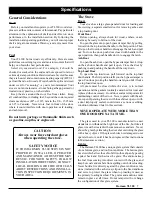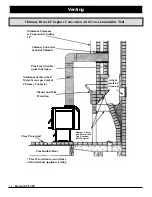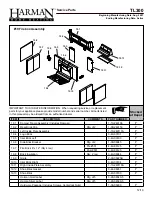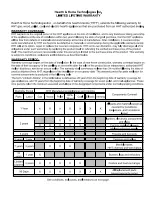
12
Harman TL300
Do not burn any fuel other than wood, such as charcoal,
which can cause increased carbon monoxide production or
overfiring. Never use highly volatile substances in your stove,
such as gasoline, which could cause an explosion.
When solid fuels are burned completely, they produce water
and carbon dioxide. However, in long slow burns, a substantial
amount of carbon monoxide may be produced. If allowed
to build up, carbon monoxide (which is odorless) can prove
fatally poisonous. Proper ventilation and draft will prevent this
from happening. If you smell smoke, turn up the air control
lever setting, and thoroughly ventilate your dwelling. During
future burns, be careful not to overload the stove with fuel,
so you will not be tempted to constantly operate at a low air
control setting.
Other causes of poor ventilation or draft are icing, exhaust
fans, a blocked outside air inlet, and room air starvation. If
your stove is sluggish and you get occasional odor, check these
possibilities and increase the air flow in your home.
venting
Do not connect to any air distribution
duct or system
Existing Masonry Chimneys
If you plan on using a pre-existing masonry chimney, have
it thoroughly inspected and cleaned. Any faults which make
the chimney unsafe and unusable must be repaired prior to
use. These can include improper height, structural defects,
blockages, inadequate clearance to combustibles, unsealed
openings into other rooms of the house, signs of creosote or
smoke leakage, a loose or absent clean-out door, or absence
of a liner.
Venting to a Masonry Chimney
When connecting to a masonry chimney, several provisions
are standard. First, whether the chimney connector is vented
to the chimney through a thimble or a breech pipe, neither
must pass beyond the inner surface of the chimney liner, and
both must be firmly cemented in place with refractory cement.
(A thimble is a masonry pipe which is inserted through the
chimney wall, and is frequently the preferred method; a breech
pipe is a piece of steel pipe used the same way.) In Canada,
a breech pipe has ridges or protrusions to lock it firmly into
the refractory cement. In either case, the chimney connector
vents to the chimney through the thimble or breech pipe.
Using a thimble, the connector slides completely inside the
masonry to the inner edge of the flue liner, and may be eas-
ily removed for chimney and connector inspection. A breech
pipe must extend at least 2" (50 mm) into the room, so the
connector can be attached with sheetmetal screws.
Venting to a Masonry Fireplace Chimney
In some situations, a code compliant chimney originally
used for a masonry fireplace may be used to install your
TL300. In addition to the requirements found in the previ-
ous paragraphs, it is important to be aware that all clearances
must be met, including those from the chimney connector to
combustibles. Do not forget to include floor protection in
your plans. (See Clearances and Floor Protection in this sec-
tion.) Since many fireplaces have exposed wooden mantels
and trim, pay special attention to the clearances necessary to
these materials.
If your fireplace chimney is behind a combustible wall,
you must use an approved wall pass-through system to gain
access to the masonry chimney. The chimney connector must
enter the chimney at a place where it is lined, and the fireplace
must be made inoperable. For example, you might remove
the damper, replacing it with a secure, airtight, noncombus-
tible seal (removable for inspection); this also satisfies the
requirement that no room air must be allowed to enter the
chimney.
Installing to a Prefabricated Chimney
When venting your TL300 using a prefabricated chimney,
be sure to contact local building code authorities, and to fol-
low the manufacturer’s instructions
exactly
. Use only the
manufacturer’s parts; do not use makeshift installation tech-
niques. All prefabricated chimneys must be tested to either
the U.S. or Canadian high-temperature standards, UL 103 or
ULC S629.
The Harman TL300 was tested with the fuel
door open and closed. Keep door closed for
normal operating conditions. If you operate
with the door open, open the by-pass damper
and put a screen over the door opening.
Содержание TL300
Страница 2: ...2 Harman TL300 ...
Страница 26: ...26 Harman TL300 This page intentionally left blank ...
Страница 27: ......
Страница 28: ......
Страница 29: ...Harman TL300 29 Notes ...
Страница 30: ...30 Harman TL300 Notes ...
Страница 31: ......
Страница 32: ...Proudly Printed On 100 Recycled Paper ...













































